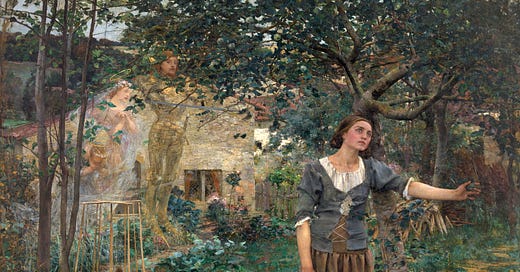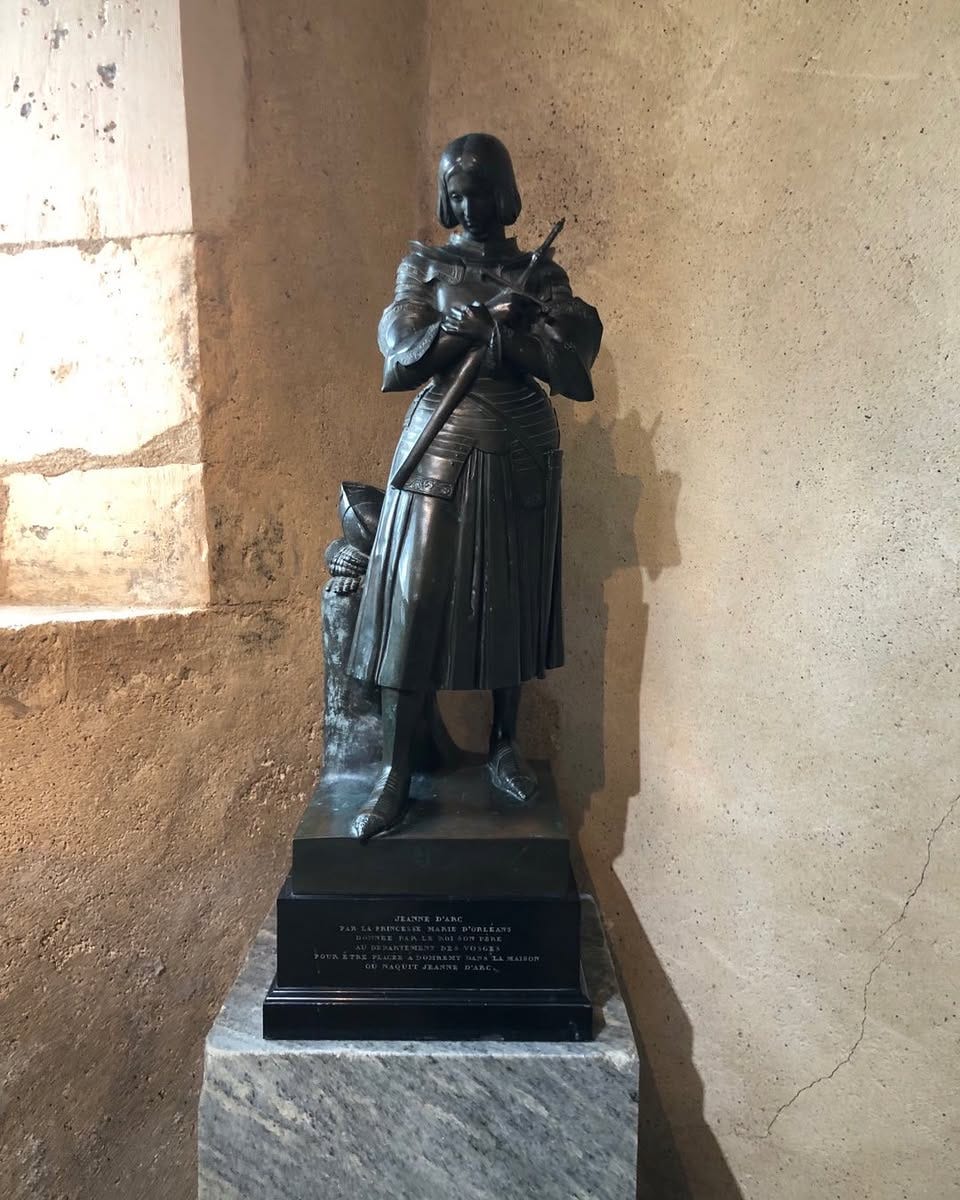In Part One of this adventure I wrote about how I was able to fulfill a vague, but nearly lifelong, desire to visit the birthplace of Joan of Arc.
As a child I had been fascinated by the story of this girl—for she was just a girl—who had had the courage, the strength, the phenomenal determination to follow through on the instructions she felt she had been given by God himself through his heavenly intermediaries—two saints and an archangel—to set things right in France.
Later, in my twenties I encountered the painting shown above in the Metropolitan Museum of Art in New York on my first visit there. I didn’t know the painting existed, but when I turned a corner to go from one gallery into the next, there it was, a massive depiction of Joan—not in battle, not in prayer, not in the agony of the flames that eventually took her young life away, as she is often depicted.
This painting shows Joan at what must have been one of the most frightening moments in her life, when she was suddenly confronted with the vision that would change her life—and, as it turns out, the history of France as well.
I stood for a long time in front of that painting that day, and it was one of the reproductions I bought in the gift shop and took home with me so I could continue to study it, in those years before the internet made such things instantly and constantly available at our fingertips.
Fast forward many years: I find myself living in France, just a couple of hours away from the place where Joan had been born and raised, and the place where she had had her vision.
And, after a few more years the right opportunity opens up, and I grab it.
I really didn’t know what to expect when I arrived at Domrémy-la-Pucelle a few weeks ago: there was very little information quickly available on the internet. I told the friend who was going to accompany me on this adventure that it was possible we would drive for two hours on some very tiny roads and then find nothing there, or maybe just an old house with a plaque on it.
As it turned out, there was quite a bit more to see, and it was definitely worth the trip. There was, for example, the beautiful basilica a short distance away from Joan’s village, already described in Part One of my adventure.

And it was in fact possible to go inside the house. It has been preserved in a very simple state—an unadorned, unembellished state that allows you to feel a connection with the life that went on there hundreds of years ago. A tour guide who was giving a little bit of background about the family who had lived there invited my friend and me to join her group. She pointed out the bedroom window through which Joan could see the little chapel next door. There is one small statue of Joan in a corner of what would have been the living room, but mostly the house is empty, which leaves visitors free to reflect on their own thoughts and feelings about the peasant girl who lived here, who took it upon herself to save a king.
There is also a nice little interpretive center a few steps away from the house, where you can study timelines, watch films, and learn more about Joan and her family. As my friend and I strolled through the exhibits I knew that I was going to have to come back again. There is so much more I want to know about this young woman and the world she lived in—and the effect she had upon her world.
Of course there is a huge bibliography of books about Joan going back hundreds of years; there is the record of her trial for witchcraft and heresy in Rouen; there is a play by George Bernard Shaw; there is a staggering amount of information one could sift through. One could—and many have—spent their lives thinking about, researching, writing about Joan of Arc. I have just recently learned that there is even a book about her written by that famous anti-Catholic religious skeptic Mark Twain. He apparently regarded this book, which was his final work, as his best, and he initially published it anonymously, because he took the story of Joan of Arc very seriously, admired her greatly, and did not want his readers to read his account as ironic or satirical.
I find that fascinating: a confirmed religious skeptic deeply admiring a mystical saint, I mean.
There may be more to come about all this; stay tuned.
Janet Hulstrand is an American writer, editor, writing coach, and teacher of writing and of literature who lives in France. She is the author of Demystifying the French: How to Love Them, and Make Them Love You, and A Long Way from Iowa: From the Heartland to the Heart of France; and coauthor of Moving On: A Practical Guide to Downsizing the Family Home. She teaches online classes for Politics and Prose bookstore in Washington DC, and is currently planning a future class that will explore the life of Joan of Arc.






I love this painting a lot…. it has so many hidden messages hidden in plain sight.